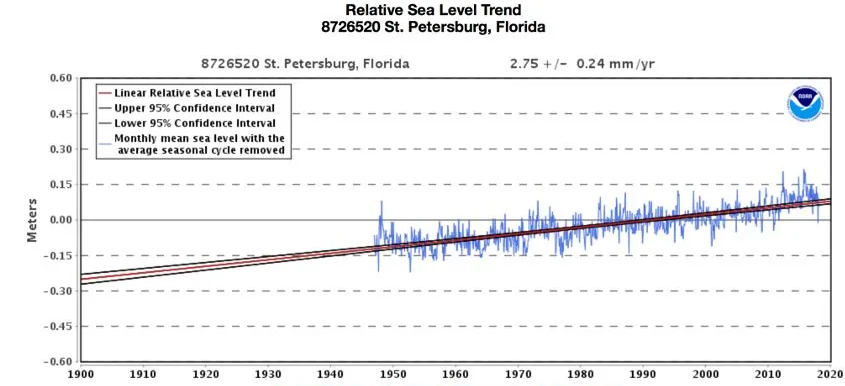Scientist Bob Bunting outlines how Florida and our region will change and how we can respond and benefit

Florida as seen from the International Space Station IMAGE: NASA
(This article was originally published June 18, 2020 in Sarasota Magazine)
During the late 1970s and 1980s, I was a scientist and executive at both the National Oceanic and Atmospheric Administration (NOAA) and the National Center for Atmospheric Research (NCAR). During this period, models clearly showed that man-made greenhouse gases were creating more rapid warming than natural climate changes occurring over thousands and millions of years. Without human greenhouse gas inputs, the model forecast little change in global temperatures, but with the impulse from mankind, the climate forecast indicated a troublesome warming during the 21st century.
Climate warming is not a theory. Since 1880, we estimate the global temperature has increased about 1.1 degrees Celsius, or about 2 degrees Fahrenheit, and sea level has risen approximately 10 inches.

The relative sea level trend is 2.75 mm/year based on monthly mean sea level data from 1947 to 2017 which is equivalent to a change of 0.90 ft in 100 years SOURCE: NOAA
Climate warming is impacting Florida now with climate disruptions, including rising sea levels, more severe hurricanes, an enhancement of red tide and other harmful algae blooms. Human health and the health of our natural environment are suffering, too.
At present, a global solution to the changing climate is not within grasp, but we can adapt and mitigate the worst impacts from the emerging disruptions even if they increase over time, as I believe is likely. If carbon emissions miraculously stopped today, the earth would continue to warm, and sea levels would continue to rise until at least 2060. By then our children and grandchildren will be as old or older than us.
If you take only one thing away from this missive it should be this. By 2100, the most likely range of temperature rise, in my opinion, is an additional 1.2 to 1.5 degrees Celsius (2.16 to 2.7 degrees Fahrenheit) rise in temperature and about 10-14 inches of further sea level rise. As the water warms in the Gulf of Mexico, there will be more fuel to intensify hurricanes and increase the impacts from red tide.
We are not without options. We can preserve the value of our real estate, limit insurance premiums and enjoy our lives if we make personal changes that are in line with the human condition of self-interest and preservation.
Think, too, about the economy. There are opportunities for small and large businesses that create and provide the adaptive solutions we need. Climate change mitigation will become one of the fastest-growing and most lucrative business categories of the 21st century. For example, coastal engineers are designing shoreline protection against additional sea level rise, manufacturers can make or deliver materials to harden and soften the shoreline to manage the rise and buffer more frequent and dangerous storm surges, consultants can help government on local, regional and national levels bridge the gap between need and implementation.
We should be helping business see this opportunity and catalyze it for everyone. Florida and the rest of the country are suffering unprecedented job losses, making this the right time for the emergence of the climate economy. But it is vitally important we switch gears now while we still have affordable and viable options.
Knowledge is advancing at such a rapid pace that 50 years from now we may well have ways to sequester carbon and reverse climate warming. In my lifetime I have witnessed an incredible and increasing rate of change in progress, as I am sure you have. This knowledge tsunami is a cause for great hope.
We can and must give humankind the chance to solve the climate crisis. And we can do that by working on implementing adaptive strategies right now. It’s not too late.
– Bob Bunting, CEO, Climate Adaptation Center

